Newest NASA Mars Rover Will Have 23 Cameras

The newest Mars rover that will be sent to the Red Planet, on target for a 2020 launch, will be far more sophisticated than those before it. Previously rovers had cameras that sent back photos but camera technology has improved greatly since those landers and rovers set out on their original journeys.
The new rover will be equipped with 23 cameras to collect photos and videos to send back to Earth. The cameras are all either descent imaging cameras, engineering cameras or science cameras. These cameras will not only take grand photos of the surface of the planet, but they’ll also be used by the craft to reveal any obstacles that might get in the way, give more information about the atmosphere on the planet and assist the science instruments on board as well, NASA said. Additionally the rover will take photos on its way down to the planet instead of waiting until it lands to start taking photos.
The Pathfinder mission that touched down in 1997 had five cameras total and the rovers that arrived at the planet afterwards, the Spirit and Opportunity rovers each had 10 cameras including those on their landers. Now the newest camera technologies will be added to the Mars 2020 mission. The cameras are expected to have more three dimensional imaging and more color imaging than the Curiosity Rover had.
The new cameras will be ideal for the rover to take expansive photos with a wide view of Mars as well as some selfies, like the other rovers have taken before. The new cameras will take 20-megapixel color images and will send back high-resolution photos like we’ve never seen of Mars before.

The issue though is that the cameras will be capable of collecting more data than can be sent from Mars to Earth. So the cameras have been designed to compress the photos and utilizing other orbiting crafts to create data relays, a method developed during the Spirit and Opportunity rover missions, said NASA in a release. The Mars Reconnaissance Orbiter, MAVEN and the Trace Gas Orbiter run by the European Space Agency will all serve as relays for the mission.
The “up look” cameras on the craft will take photos of the parachute’s inflation as well as the descent stage as the rover lowers from the sky crane while the “down look” cameras will get a view of the rover from above on its way down along with one to look at the approaching ground. All of these views thanks to the cameras will give researchers a realistic view of what the ride down to the surface of the planet is like
© Copyright IBTimes 2024. All rights reserved.



















